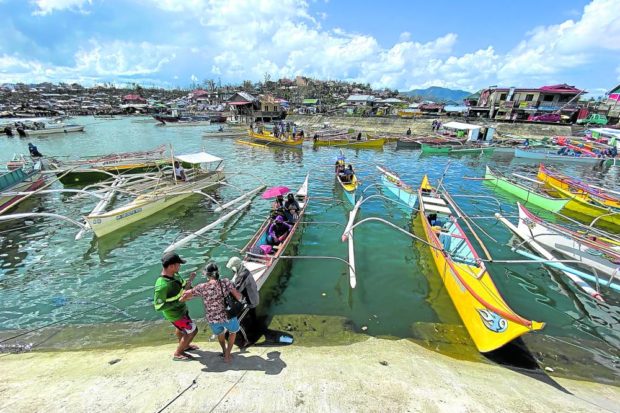Scramble for rides to bring aid to kin in Siargao, Dinagat

ALTERNATIVE TRANSPORT Fishing boats are being offered by fishermen on Thursday to ferry passengers to Siargao and Dinagat Islands from Surigao City with commercial ferries fully booked with travelers heading home to spend Christmas with and to bring relief goods to their typhoon-affected relatives. —ERWIN M. MASCARIÑAS
SURIGAO CITY — Ana Marie Podadera, 19, was already at the city’s port area at 3 a.m. on Thursday to line up for a ticket for a ferry trip to Siargao Island to check on her parents, whose fate amid the onslaught of Typhoon “Odette” (international name: Rai) remained unknown to her.
After over two hours of patient wait, she got the pass for a 3 p.m. trip, allowing her time to buy rice, canned goods, some blankets and even candles since electricity has yet to be restored on the island.
“These are what my family needs now,” she told the Inquirer of her purchase list.
Since trips resumed on Dec. 21, passengers going to Siargao and Dinagat Islands have been scrambling for tickets to limited ferry trips for a chance to reunite with their families for the Christmas holiday, which has attained more significance after they suffered through Odette’s fury.
Like Podadera, the travelers mostly came with packs of food and water.
Article continues after this advertisementAlternative transports for Dinagat were also provided by fishermen desperate to earn income to rebuild their homes. These were fishers who brought their catch to Surigao City and would be returning home on empty boats. But a ride to Dinagat would cost P1,000 per person from the usual P230 to P250 collected by commercial ferries.
Article continues after this advertisementTrips going to Surigao City’s island villages, although shorter, were greatly hampered by the destruction of motor launches that ply these routes. A trip to San Pedro, for example, now costs P250 from what used to be P80 per passenger. There was a separate charge for cargoes.Food, gas sources
Economic activities in typhoon-battered Surigao City have slowly resumed.
One bank has operated since Tuesday, although its transactions were hampered by unstable internet connection. Grocery stores have reopened but owners have regulated the volume of goods sold per customer in order to distribute available supply to as many people. As the public market was still in ruins, vendors lined up on the roads that had been cleared of debris.
Those who wanted to buy food in bulk trooped to Butuan City, some 120 kilometers away, and on to Cagayan de Oro City, an additional 170 km. —WITH A REPORT FROM EDWIN M. MASCARIÑAS